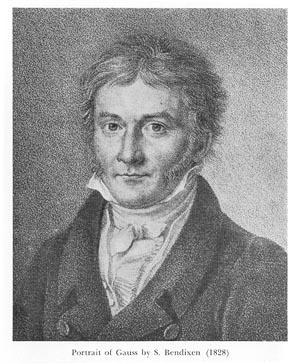![]()
 Johann Carl Friedrich Gauss was born on April 30th, 1777, in the German city of Braunschweig (Brunswick). He was the only child of Gebhard Dietrich Gauss and Dorothea Benze. Neither of Gauss’s parents had much education: his father could read and write but earned his living doing menial jobs such as gardening and as a street butcher, his mother could read but not write.
Johann Carl Friedrich Gauss was born on April 30th, 1777, in the German city of Braunschweig (Brunswick). He was the only child of Gebhard Dietrich Gauss and Dorothea Benze. Neither of Gauss’s parents had much education: his father could read and write but earned his living doing menial jobs such as gardening and as a street butcher, his mother could read but not write.
In 1784 Gauss entered elementary school. He was one of fifty students in the class. Gauss knew how to read and write before entering school, skills he appears to have learnt without any help from his parents. Gauss was lucky to have a competent and concerned teacher, Buttner, and assistant teacher Bartels who took a personal interest in Gauss, trying to help and encourage him. His teachers were amazed when asked to sum the numbers 1 to 100 Gauss added
Carl Friedrich left his parents' home in 1788 when Buttner helped him be admitted to secondary school. The lectures were orderly and regular with smaller class sizes and with students who all had the same level of knowledge. The curriculum was old-fashioned and unbalanced, with an over-emphasis on Latin and High German. While still a teenager, Gauss propounded the theory of least squares, demonstrated a solution to the age-old problem of dividing a circle into 17 parts, and made important mathematical discoveries which he was too shy to publish and entrusted only to his diary.
In 1791 Gauss was introduced to his prince, Duke of Brunswick-Wolfenbuttel, who undertook to finance his education and, in the process, became his lifelong patron and friend. Gauss attended the University of Göttingen and in 1799 obtained a Doctorate in Mathematics from the University of Helmstedt. About this time he turned his attention to astronomy, making brilliant computations of orbits of asteroids.
Gauss married Johanna Ostoff on 9 October, 1805. He now had a happy personal life for the first time, although his benefactor, the Duke of Brunswick, was killed fighting for the Prussian army. In 1807, Gauss became director of the observatory in Göttingen, a post he held until his death in 1855. In 1808 his father died, and a year later Gauss’s wife Johanna died after giving birth to their second son, who was to die soon after her. Gauss was married for a second time the next year, to Minna, the best friend of Johanna, and although they had three children, this marriage seemed to be one of convenience for Gauss. The period 1817 – 1832 was a particularly distressing time for Gauss. He took in his sick mother in 1817, who stayed until her death in 1839, while he was arguing with his wife and her family about whether they should go to Berlin. He had been offered a position at Berlin University and Minna and her family were keen to move there. Gauss, however, never liked change and decided to stay in Göttingen. In 1831 Gauss’s second wife died after a long illness. Gauss died in his sleep early in the morning of 23 February, 1855.
Most of Gauss’s contributions to mathematics and science were written in about 155 papers. He published anything only after the most thorough investigation and after he was sure it met his motto: “Ut nihil amplius desiderandum relictum sit” – that nothing further remains to be done. His mind was so full of numbers that when he was interrupted in solving a problem, and told that his wife was dying, he reportedly replied: “Tell her to wait until I am done.”